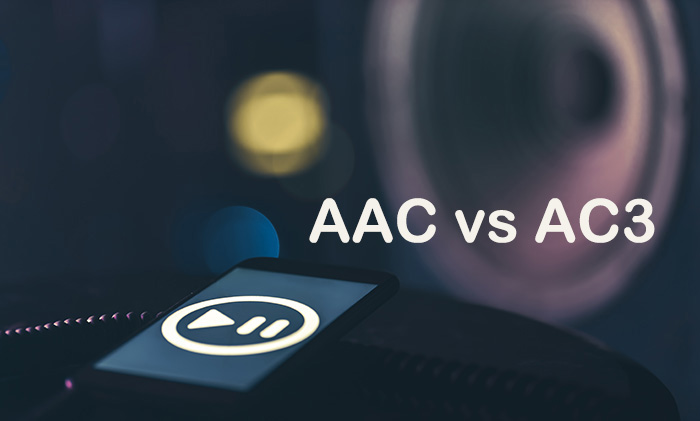"I bought a digital camera with Dolby digital stereo sound. AVCHD file uses AC3 audio code and MP4 files uses AAC audio code. I really want to know the difference between AC3 and AAC in quality and which is better AAC or AC3. What's more, does AAC also use Dolby digital?"
Beyond question, most of people badly need to know AAC advantages and disadvantages and AC3 pros and cons especially when shooting video with digital cameras or converting audio formats for playback on mobile devices. Since there is no clearly defined standard used to judge AAC and AC3 which is good, users need figure out their real meaning respectively before make any comparison regarding AAC VS AC3.
Best Free AAC AC3 Music/Video/Movie Downloader & Player
5KPlayer - 100% free music video player & downloader provides you the easiest way to play & download AAC AC3 MP3 FLAC music video as well as playback MKV MP4 FLV AVI MOV 3GP WMV MTS, M2TS, DVD video/movie on your Windows (10) and Mac (10.11) smoothly & clearly!
AAC and AC3 Definition
What is AAC Format?
Known as the abbreviation of Advanced Audio Coding, AAC is designed to be the successor of the MP3 format, which has better sound quality than MP3 at the similar bit rates. Developed by the MPEG group, AAC employs sophisticated algorithms to efficiently encode audio data by discarding imperceptible information. This results in smaller files ideal for streaming and storage, without compromising audio fidelity. AAC has become a standard for various applications, from music streaming to video content. Surely enough, AAC is an audio coding standard for lossy digital audio compression.
What is AC3 Format?
AC3, the abbreviation of Audio Coding, is the synonym of Dolby Digital audio codec. Except for Dolby TrueHD, the audio compression is lossy. And Dolby Digital is the common version containing up to six discrete channels of sound. Developed by Dolby Laboratories, AC3 focuses on preserving audio quality while enabling cinematic experiences through surround sound technology. It excels in home theater setups, DVDs, and broadcast applications by efficiently encoding audio data with minimal loss.

AAC VS AC3: History
Developed with the cooperation of companies including AT&T Bell Laboratories, Fraunhofer IIS, Dolby Laboratories, Sony Corporation and Nokia, AAC, was claimed as an international standard by the Moving Picture Experts Group in April 1997.
AC3 was originally named Dolby Stereo Digital until 1994. In the early 1997, Dolby Laboratories officially changed "Dolby AC-3 surround sound" to "Dolby Surround Digital" which we often called as Dolby Digital.
AC3(Dolby Digital) VS AAC: Compatibility
So far, AAC is the default audio format for YouTube, iPhone, iPod, iPad, Nintendo DSi/3DS, iTunes, DivX Plus Web Player and PlayStation 3. It is well supported by PlayStation Vita, Wii (with the Photo Channel 1.1 update installed), Sony Walkman MP3 series and later, Sony Ericsson; Nokia, Android, BlackBerry, and webOS-based mobile phones. And a majority of in-dash car audio system manufacturers will adopt AAC.
AC3 (Dolby Digital) excels in delivering immersive surround sound experiences, making it a standard choice for movies, TV shows, and broadcast audio. AC3 is prevalent in legacy gaming consoles, broadcast television, and DVDs, ensuring dynamic audio effects. While newer platforms may favor more efficient codecs, AC3 remains suitable for various contexts.
Comparison Between AAC and AC3 in Quality
As part of the MPEG-4 standard, AAC codec makes small digital audio files so that it can store a larger amount of audio files using less space while preserving sound quality. Normally, AAC can produce frequency ranges from 8 to 96 kilohertz. While AC3 provides a total bit rate of 384 kilobits per second. Its sample rates can up to 48 kilohertz. And if you want to enjoy the full effect of the AC3 track, you should choose an amplified theater system which supports Dolby Digital.
You may also interested: H.265 vs H.264
In a conclusion, AAC is a more advanced lossy audio format comparing with AC3. It will produce better audio quality than AC3 with the same bitrate, especially on low bitrates. The main advantage of using AC3 is for backward compatibility on older Dolby Digital equipments.
AAC VS AC3: Respective Pros and Cons
Whether you're an audiophile, a content creator, or simply a curious enthusiast, understanding the intricacies of AAC and AC3 will empower you to make informed decisions about audio compression for various purposes. The following table will outline the main differences between AAC and AC3.
|
Advantages |
Disadvantages |
AAC |
1. As part of MPEG-4 specs, AAC is an international standard approved by the ISO. It supports several sampling rates (8000-96000 Hz), bit depths, and multichannel (up to 48 channels). |
AAC comes in different object types like AAC LC, AAC HE, AAC PS etc, which will lead to many portable players (only support LC) can't play these valid AAC files. |
AC3 |
1. AC3 provides only full range channels and its sound quality is really much better. It is also backward compatible. |
Max support for 5.1 channel audio CDs, limited to 448 kbps maximum for Digital Dolby. |
FAQs about AAC vs AC3
What is the difference between AAC and AC3 audio?
AAC (Advanced Audio Coding) and AC3 (Audio Coding 3) are both audio compression technologies used to encode digital audio for various applications. They differ in several aspects, including their compression methods, quality, compatibility, and usage. AAC is favored for its higher sound quality at lower bit rates and broader compatibility, while AC3 is commonly used in home entertainment systems for its surround sound capabilities.
What is the difference between AC3 and AAC file size?
The file size of AC3 (Audio Coding 3) and AAC (Advanced Audio Coding) audio files can vary depending on several factors, including the bit rate, audio content, duration of the audio, and the specific compression settings used. Generally speaking, AAC tends to provide better compression efficiency than AC3, which means that AAC files can be smaller for the same perceived audio quality.
Is AAC the same as Dolby Digital?
No, AAC (Advanced Audio Coding) is not the same as Dolby Digital. They are two distinct audio compression technologies developed by different organizations and serving different purposes. AAC is more versatile and commonly used for a wide range of applications, while Dolby Digital is often associated with surround sound experiences in home theaters and cinematic settings.
AAC vs AC3 for Plex
When it comes to choosing between AAC and AC3 for Plex, you're essentially deciding on the audio codec to use for your media content within the Plex media server. Check the devices and players you plan to use with Plex. Most modern devices support AAC, but if you have older equipment, AC3 might be more suitable. If you're primarily using Plex for a home theater setup with surround sound, AC3 might be preferable to provide the best audio experience. For general streaming, AAC is more versatile and widely compatible.








